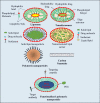Deciphering the role of nanoparticles for management of bacterial meningitis: an update on recent studies
- PMID: 34545518
- PMCID: PMC8452126
- DOI: 10.1007/s11356-021-16570-y
Deciphering the role of nanoparticles for management of bacterial meningitis: an update on recent studies
Abstract
Meningitis is an inflammation of the protective membranes called meninges and fluid adjacent the brain and spinal cord. The inflammatory progression expands all through subarachnoid space of the brain and spinal cord and occupies the ventricles. The pathogens like bacteria, fungi, viruses, or parasites are main sources of infection causing meningitis. Bacterial meningitis is a life-threatening health problem that which needs instantaneous apprehension and treatment. Nesseria meningitidis, Streptococcus pneumoniae, and Haemophilus flu are major widespread factors causing bacterial meningitis. The conventional drug delivery approaches encounter difficulty in crossing this blood-brain barrier (BBB) and therefore are insufficient to elicit the desired pharmacological effect as required for treatment of meningitis. Therefore, application of nanoparticle-based drug delivery systems has become imperative for successful dealing with this deadly disease. The nanoparticles have ability to across BBB via four important transport mechanisms, i.e., paracellular transport, transcellular (transcytosis), endocytosis (adsorptive transcytosis), and receptor-mediated transcytosis. In this review, we reminisce distinctive symptoms of meningitis, and provide an overview of various types of bacterial meningitis, with a focus on its epidemiology, pathogenesis, and pathophysiology. This review describes conventional therapeutic approaches for treatment of meningitis and the problems encountered by them while transmitting across tight junctions of BBB. The nanotechnology approaches like functionalized polymeric nanoparticles, solid lipid nanoparticles, nanostructured lipid carrier, nanoemulsion, liposomes, transferosomes, and carbon nanotubes which have been recently evaluated for treatment or detection of bacterial meningitis have been focused. This review has also briefly summarized the recent patents and clinical status of therapeutic modalities for meningitis.
Keywords: Bacterial meningitis;; Blood-brain barrier;; Nanoparticles;; Paracellular transport;; Transcytosis.
© 2021. The Author(s), under exclusive licence to Springer-Verlag GmbH Germany, part of Springer Nature.
Conflict of interest statement
The authors declare no competing interests.
Figures





References
Publication types
MeSH terms
Substances
LinkOut - more resources
Full Text Sources

